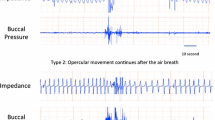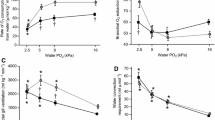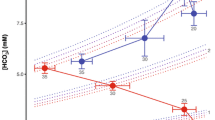Abstract
The aim of this study was to corroborate the presence of CO2/H+-sensitive arterial chemoreceptors involved in producing air-breathing responses to aquatic hypercarbia in the facultative air-breathing clown knifefish (Chitala ornata) and to explore their possible location. Progressively increasing levels of CO2 mixed with air were injected into the air-breathing organ (ABO) of one group of intact fish to elevate internal PCO2 and decrease blood pH. Another group of fish in which the gills were totally denervated was exposed to aquatic hypercarbia (pH ~ 6) or arterial hypercapnia in aquatic normocarbia (by injection of acetazolamide to increase arterial PCO2 and decrease blood pH). Air-breathing frequency, gill ventilation frequency, heart rate and arterial PCO2 and pH were recorded during all treatments. The CO2 injections into the ABO induced progressive increases in air-breathing frequency, but did not alter gill ventilation or heart rate. Exposure to both hypercarbia and acetazolamide post-denervation of the gills also produced significant air-breathing responses, but no changes in gill ventilation. While all treatments produced increases in arterial PCO2 and decreases in blood pH, the modest changes in arterial PCO2/pH in the acetazolamide treatment produced the greatest increases in air-breathing frequency. These results strengthen the evidence that internal CO2/H+ sensing is involved in the stimulation of air breathing in clown knifefish and suggest that it involves extra-branchial chemoreceptors possibly situated either centrally or in the air-breathing organ.





Similar content being viewed by others
References
Abdallah SJ, Thomas BJ, Jonz MG (2015) Aquatic surface respiration and swimming behaviour in adult and developing zebrafish exposed to hypoxia. J Exp Biol 218:777–1786
Babiker M (1979) Respiratory behaviour, oxygen consumption and relative dependence on aerial respiration in the African lungfish (Protopterus annectens, owen) and an air-breathing teleost (Clarias lazera, C.). Hydrobiologia 65(2):177–187
Bayley M, Damsgaard C, Thomsen M, Malte H, Wang T (2019) Learning to air-breathe: the first steps. Physiology 34:14–29
Burleson ML (2009) Sensory innervation of the gills: O2-sensitive chemoreceptors and mechanoreceptors. Acta Histochem 111:196–206
Burleson ML, Milsom WK (1993) Sensory receptors in the first gill arch of rainbow trout. Respir Physiol 93:97–110
Burleson ML, Smatresk NJ (1990) Effects of sectioning cranial nerves IX and X on cardiovascular and ventilatory responses to hypoxia and NaCN in channel catfish. J Exp Biol 154:407–420
Corcoran A, Wilson R, Harris M (2007) Central CO2/pH chemo-sensitivity in a modern air-breathing teleost; evidence in vitro and in vivo. Soc Neurosci Abstr 297:11
Damsgaard C, Tuong DD, Thinh PV, Wang T, Bayley M (2015) High capacity for extracellular acid–base regulation in the air-breathing fish Pangasianodon hypophthalmus. J Exp Biol 218(9):1290–1294
de Lima Boijink C, Florindo LH, Leite CA, Kalinin AL, Milsom WK, Rantin FT (2010) Hypercarbic cardiorespiratory reflexes in the facultative air-breathing fish jeju (Hoplerythrinus unitaeniatus): the role of branchial CO2 chemoreceptors. J Exp Biol 213(Pt 16):2797–2807. https://doi.org/10.1242/jeb.040733
Dehadrai PV (1962) Respiratory function of the swimbladder of Notopterus (Lacépède). In: Paper presented at the proceedings of the zoological society of London, vol 139, no 2. Blackwell Publishing Ltd, Oxford, UK, pp 341–357
Dejours P (1981) Principles of comparative respiratory physiology, 2nd edn. Elsevier Science & Technology, Amsterdam
Delaney R, Lahiri S, Fishman A (1974) Aestivation of the African lungfish Protopterus aethiopicus: cardiovascular and respiratory functions. J Exp Biol 61(1):111–128
Delaney RG, Shub C, Fishman AP (1976) Haematologic observations on the aquatic and aestivating African lungfish Protopterus aethiopicus. Copeia 1976:423–434
DeLaney R, Lahiri S, Hamilton R, Fishman P (1977) Acid-base balance and plasma composition in the aestivating lungfish (Protopterus). Am J Physiol Regulat Integr Comp Physiol 232(1):R10–R17
Florindo LH, Reid SG, Kalinin AL, Milsom WK, Rantin FT (2004) Cardiorespiratory reflexes and aquatic surface respiration in the neotropical fish tambaqui (Colossoma macropomum): acute responses to hypercarbia. J Comp Physiol B 174(4):319–328
Gam LTH, Jensen FB, Huong DTT, Phuong NT, Bayley M (2018) The effects of elevated environmental CO2 on nitrite uptake in the air-breathing clown knifefish, Chitala ornata. Aquat Toxicol 196:124–131
Gilmour KM (2001) The CO2/pH ventilatory drive in fish. Comp Biochem Physiol Part A Mol Integr Physiol 130(2):219–240
Gilmour K, Milsom W, Rantin F, Reid S, Perry S (2005) Cardiorespiratory responses to hypercarbia in tambaqui Colossoma macropomum: chemoreceptor orientation and specificity. J Exp Biol 208(6):1095–1107
Graham JB, Baird TA (1982) The transition to air breathing in fishes: I. Environmental effects on the facultative air breathing of Ancistrus chagresi and Hypostomus plecostomus Loricariidae. J Exp Biol 96(1):53–67
Graham JB (ed) (1997) Air-breathing fishes: evolution, diversity, and adaptation. Elsevier
Graham M, Turner J, Wood C (1990) Control of ventilation in the hypercapnic skate Raja ocellata: I. Blood and extradural fluid. Respir Physiol 80(2–3):259–277
Hedrick MS, Jones DR (1999) Control of gill ventilation and air-breathing in the bowfin Amia calva. J Exp Biol 202(1):87–94
Hedrick M, Burleson M, Jones D, Milsom W (1991) An examination of central chemosensitivity in an air-breathing fish (Amia calva). J Exp Biol 155(1):165–174
Heisler N, Toews DP, Holeton GF (1988) Regulation of ventilation and acid-base status in the elasmobranch Scyliorhinus stellaris during hyperoxia-induced hypercapnia. Respir Physiol 71(2):227–246
Hoffman M, Harris MB, Taylor BE (2009) Characterization and validation of aerial respiration and central CO2 chemosensitivity in the Alaska blackfish, Dallia pectoralis. FASEB J 23(1 Supplement):598.516
Jesse MJ, Shub C, Fishman AP (1967) Lung and gill ventilation of the African lung fish. Respir Physiol 3(3):267–287
Johansen K (1966) Air breathing in the teleost Symbranchus marmoratus. Comp Biochem Physiol 18(2):383–395
Johansen K, Lenfant C, Grigg GC (1967) Respiratory control in the lungfish, Neoceratodus forsteri (Krefft). Comp Biochem Physiol 20(3):835–854
Johansen K, Hanson D, Lenfant C (1970) Respiration in a primitive air breather, Amia calva. Respir Physiol 9(2):162–174
Jonz MG, Zachar PC, Da Fonte DF, Mierzwa AS (2015) Peripheral chemoreceptors in fish: a brief history and a look ahead. Comp Biochem Physiol Part A Mol Integr Physiol 186:27–38
Li S, Lu X, Bush RT (2013) CO2 partial pressure and CO2 emission in the Lower Mekong River. J Hydrol 504:40–56
Lomholt JP, Johansen K (1974) Control of breathing in Amphipnous cuchia, an amphibious fish. Respir Physiol 21(3):325–340
Lopes JM, de Lima Boijink C, Florindo LH, Leite CAC, Kalinin AL, Milsom WK, Rantin FT (2010) Hypoxic cardiorespiratory reflexes in the facultative air-breathing fish jeju (Hoplerythrinus unitaeniatus): role of branchial O2 chemoreceptors. J Comp Physiol B 180(6):797–811
McKendry J, Perry S (2001) Cardiovascular effects of hypercarbia in rainbow trout (Oncorhynchus mykiss): a role for externally oriented chemoreceptors. J Exp Biol 204(1):115–125
McKenzie DJ, Burleson ML, Randall DJ (1991) The effects of branchial denervation and pseudobranch ablation on cardioventilatory control in an air-breathing fish. J Exp Biol 161:347–365
McMahon BR, Burggren WW (1987) Respiratory physiology of intestinal air breathing in the teleost fish Misgurnus anguillicaudatus. J Exp Biol 133(1):371–393
Milsom WK (2012) New insights into gill chemoreception: receptor distribution and roles in water and air breathing fish. Respir Physiol Neurobiol 184(3):326–339
Milsom WK, Brill RW (1986) Oxygen sensitive afferent information arising from the first gill arch of yellowfin tuna. Respir Physiol 66:193–203
Perry SF, Gilmour KM (2002) Sensing and transfer of respiratory gases at the fish gill. J Exp Zool 293:249–263
Perry SF, Reid SG (2002) Cardiorespiratory adjustments during hypercarbia in rainbow trout Oncorhynchus mykiss are initiated by external CO2 receptors on the first gill arch. J Exp Biol 205(21):3357–3365
Perry SF, Gilmour KM, Swenson ER, Vulesevic B, Chew SF, Ip YK (2005) An investigation of the role of carbonic anhydrase in aquatic and aerial gas transfer in the African lungfish (Protopterus dolloi). J Exp Biol 208:3805–3815
Perry SF, Euverman R, Wang TAM, Chew SF, Ip YK, Gilmour KM (2008) Control of breathing in the African lungfish (Protopterus dolloi); a comparison of aquatic and cacooned (terrestrialized) animals. Respir Physiol Neurobiol 160:8–17
Phuong LM, Damsgaard C, Ishimatsu A, Wang T, Bayley M (2016) Recovery of blood gases and haematological parameters upon anaesthesia with benzocaine, MS-222 or Aqui-S in the air-breathing catfish Pangasianodon hypophthalmus. Ichthyol Res 1(64):84–92
Poulsen AF, Hortle K, Valbo-Jorgensen J, Chan S, Chhuon C, Viravong S, Nguyen T (2004) Distribution and ecology of some important riverine fish species of the Mekong River Basin. MRC Tech Paper 10:116
Qin F, Wang S, Hartono A, Svendsen HF, Chen C (2010) Kinetics of CO2 absorption in aqueous ammonia solution. Int J Greenhouse Gas Control 4(5):729–738
Rahn H (1966) Aquatic gas exchange: theory. Respir Physiol 1(1–12):1966. https://doi.org/10.1016/0034-5687(66)90024-7
Reid SG, Sundin L, Kalinin AL, Rantin FT, Milsom WK (2000) Cardiovascular and respiratory reflexes in the tropical fish, traira (Hoplias malabaricus): CO2/pH chemoresponses. Respir Physiol 120(1):47–59
Sanchez A, Glass M (2001) Effects of environmental hypercapnia on pulmonary ventilation of the South American lungfish. J Fish Biol 58(4):1181–1189
Sanchez A, Soncini R, Wang T, Koldkjaer P, Taylor EW, Glass ML (2001) The differential cardio-respiratory responses to ambient hypoxia and systemic hypoxaemia in the South American lungfish, Lepidosiren paradoxa. Comp Biochem Physiol Part A Mol Integr Physiol 130(4):677–687
Sanchez A, Giusti H, Bassi M, Glass M (2005) Acid-base regulation in the South American lungfish Lepidosiren paradoxa: effects of prolonged hypercarbia on blood gases and pulmonary ventilation. Physiol Biochem Zool 78(6):908–915
Smith HW (1930) Metabolism of the lung-fish, Protopterus aethiopicus. J Biol Chem 88(1):97–130
Soivio A, Nynolm K, Westman K (1975) A technique for repeated sampling of the blood of individual resting fish. J Exp Biol 63(1):207–217
Sundin L, Reid SG, Kalinin AL, Rantin FT, Milsom WK (1999) Cardiovascular and respiratory reflexes in the tropical fish, traira (Hoplias malabaricus): O2 chemoresponses. Respir Physiol 116:181–199
Sundin L, Reid SG, Rantin FT, Milsom WK (2000) Branchial receptors and cardiorespiratory reflexes in a neotropical fish, the tambaqui (Colossoma macropomum). J Exp Biol 203(7):1225–1239
Thomas S, Le Ruz H (1982) A continuous study of rapid changes in blood acid–base status of trout during variations of water PCO2. J Comp Physiol B 148:123–130
Thomsen MT, Wang T, Milsom WK, Bayley M (2017) Lactate provides a strong pH-independent ventilatory signal in the facultative air-breathing teleost Pangasianodon hypophthalmus. Sci Rep 7(1):6378
Tuong DD, Borowiec B, Clifford AM, Filogonio R, Somo D, Huong DTT, Phuong NT, Wang T, Bayley M, Milsom WK (2018a) Ventilatory responses of the clown knifefish, Chitala ornata, to hypercarbia and hypercapnia. J Comp Physiol B 188:581–589
Tuong DD, Ngoc TB, Huynh VTN, Phuong NT, Hai TN, Wang T, Bayley M (2018b) Clown knifefish (Chitala ornata) oxygen uptake and its partitioning in present and future temperature environments. Comp Biochem Physiol Part A Mol Integr Physiol 216:52–59
Ultsch GR (1987) The potential role of hypercarbia in the transition from water-breathing to air-breathing in vertebrates. Evolution 41(2):442–445
Vidthayanon C (2012) Chitala ornata. The IUCN red list of threatened species. https://doi.org/10.2305/IUCN.UK.2012-1.RLTS.T181056A1693604.en
Viet TV (2015) Applications of GIS for evaluation the current culture status of Clown knife fish (Chitala ornata) in Phung Hiep District, Hau Giang Province. J Can Tho Univ 38:109–115
Wilson R, Harris M, Remmers J, Perry S (2000) Evolution of air-breathing and central CO(2)/H (+) respiratory chemosensitivity: new insights from an old fish? J Exp Biol 203(22):3505–3512
Wood C, Munger R (1994) Carbonic anhydrase injection provides evidence for the role of blood acid-base status in stimulating ventilation after exhaustive exercise in rainbow trout. J Exp Biol 194(1):225–253
Wood C, Turner J, Munger R, Graham M (1990) Control of ventilation in the hypercapnic skate Raja ocellata: II. cerebrospinal fluid and intracellular pH in the brain and other tissues. Respir Physiol 80(2–3):279–297
Zaconne G, Lauriano ER, Capillo G, Kuciel M (2018) Air- breathing in fish: air-breathing organs and control of respiration. Nerves and neurotransmitters in the air-breathing organs and the skin. Acta Histochem 120:630–641
Zhang L, Nawata CM, De Boeck G, Wood CM (2015) Rh protein expression in branchial neuroepithelial cells, and the role of ammonia in ventilatory control in fish. Comp Biochem Physiol A 186:39–51
Acknowledgements
This research was funded by the Danish Ministry of Foreign Affairs: Danida fellowship Centre Project 272 number: DFC 12-014 AU iAQUA, The Danish International Development Agency (DANIDA) and by the Natural Sciences and Engineering Research Council of Canada.
Author information
Authors and Affiliations
Corresponding author
Additional information
Communicated by B. Pelster.
Publisher's Note
Springer Nature remains neutral with regard to jurisdictional claims in published maps and institutional affiliations.
Dang Diem Tuong and Do Thi Thanh Huong are co-first authors.
Rights and permissions
About this article
Cite this article
Tuong, D.D., Huong, D.T.T., Phuong, N.T. et al. Ventilatory responses of the clown knifefish, Chitala ornata, to arterial hypercapnia remain after gill denervation. J Comp Physiol B 189, 673–683 (2019). https://doi.org/10.1007/s00360-019-01236-6
Received:
Revised:
Accepted:
Published:
Issue Date:
DOI: https://doi.org/10.1007/s00360-019-01236-6




